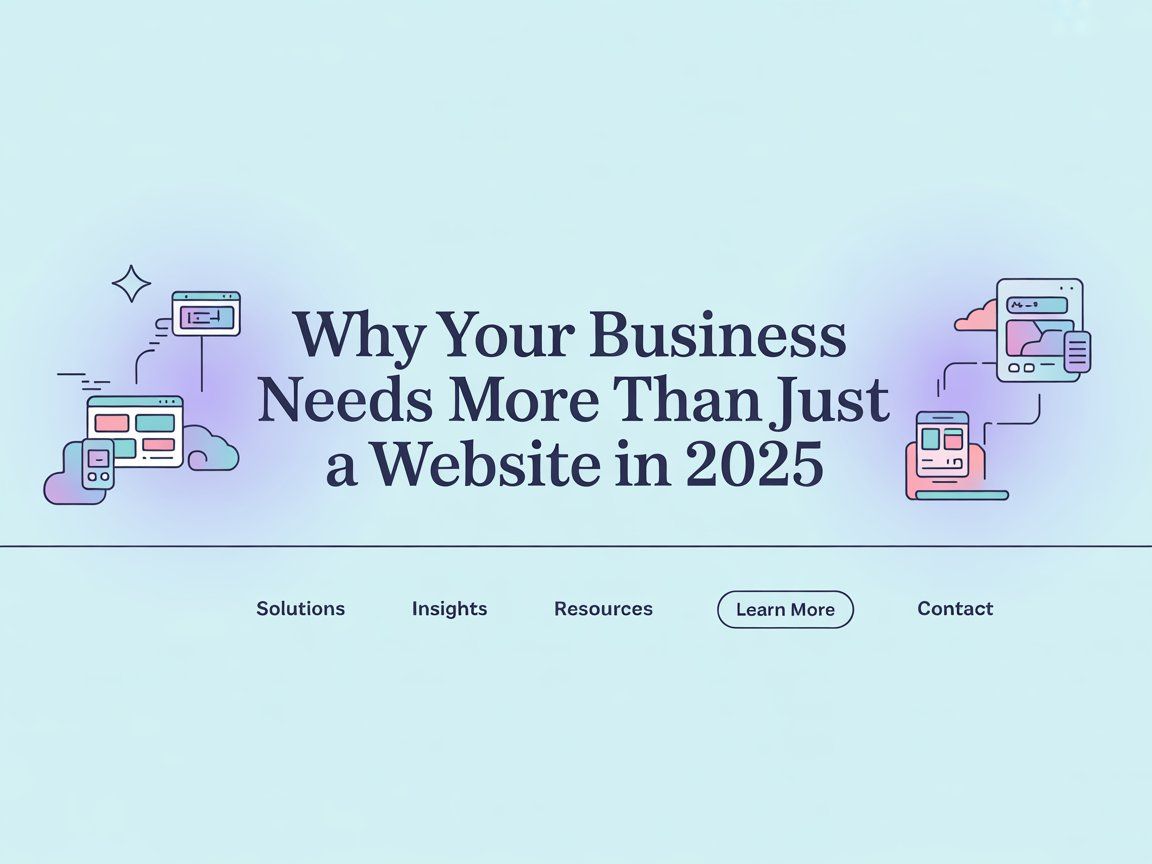
In 2025, businesses need more than a website. Discover tools to optimize communication, operations, and marketing for a thriving digital presence.
Let’s be honest—there was a time when simply having a website felt like winning. If you had a homepage, a few product pages, and a contact form, you were good to go. But in 2025? That’s just the beginning.
A website is still essential—it’s your digital front door. But the businesses that are really winning today have built more than just a door. They’ve built systems, automations, and experiences that work behind the scenes to support customers and streamline operations while scaling with confidence.
If your entire digital presence starts and ends with your website, you’re probably leaving a lot on the table. Let’s explore why, and what else successful businesses are using to stay ahead.
Your Website: The Starting Line, Not the Finish Line
Your website introduces you to the world. It tells people who you are and what you offer. But that’s just one piece of the puzzle. Customers don’t only want information—they want a seamless experience. And most of that happens beyond your homepage.
A high-performing business doesn’t just exist online—it operates online. That means having tools that support communication, team productivity, decision-making, and customer service. Let’s dig into the types of software and systems that bring all this together.
1. Communication Tools That Keep You Connected
In 2025, communication is everything. Customers expect quick answers, and teams—often working in hybrid or remote environments—need to stay in sync across locations, time zones, and departments. Just having a contact form isn’t enough anymore.
Instead, high-performing businesses rely on live chat, AI assistants, and help desk platforms to handle customer questions faster and better. These tools make it easier to respond in real time, automate common answers, and keep conversations organized.
Internally, teams are moving away from endless email threads and using chat tools or shared workspaces that help conversations happen where the work is. When communication improves, everything else gets easier.
2. Behind-the-Scenes Tools That Power Your Operations
A polished website might attract visitors, but it’s your internal systems that keep the business running smoothly. Whether it’s assigning tasks, managing projects, or tracking team output, you need tools that help your day-to-day operations run on rails.
This is where business management platforms come into play. Project management tools help you assign work, set priorities, and keep projects moving. CRM systems keep your leads and customer data organized. And cap table management software also plays a vital role, helping startups track ownership and equity with clarity. It ensures transparency and simplifies investor reporting.
Moreover, tools like employee monitoring software give you visibility into how your team is working—especially useful in hybrid or remote environments where that insight isn’t always visible.
By connecting your website to these tools, you move from looking organized to actually being organized.
3. Marketing Tools That Work While You Sleep
In 2025, businesses are moving away from manual outreach and embracing software that runs in the background—sending emails, posting on social, and following up with leads based on behavior.
These tools help you stay top-of-mind without having to lift a finger every time. They segment your audience, personalize messages, and track engagement across channels. Whether you’re reminding customers about an abandoned cart or welcoming new subscribers, automation ensures the right message hits at the right time.
This frees you up to focus on strategy and creativity, instead of juggling campaigns all day.
4. Tools That Help You See What’s Actually Working
How do you know if your website is doing its job? How do you know if your team is spending time on the right things?
That’s where analytics and insight tools come in. These platforms give you the data you need to make smart decisions—from which pages convert best to where customers are dropping off.
Even internally, tracking performance matters. A simple time tracker with screenshots can show you exactly how time is being spent across different projects or departments. This kind of visibility helps managers allocate resources better, and it also empowers teams to work smarter, not harder.
When you can measure it, you can improve it.
5. Workflow Tools That Bring Everything (and Everyone) Together
Most businesses don’t struggle because of a lack of talent—they struggle because people working in hybrid or remote environments are using five different tools to do the same thing.
These tools help teams create shared spaces where ideas, docs, tasks, and goals live together. Resource planning software often complements these platforms by ensuring the right people and resources are allocated effectively, streamlining workflows even further. No more digging through folders or asking, “Where’s that file?” Everything is in one place, easy to find, and even easier to act on.
Whether you’re creating a project dashboard, a team knowledge base, or just managing everyday tasks, having a tool that brings it all together keeps everyone aligned. And less time spent chasing down updates means more time getting real work done. For industries that require around-the-clock operations like manufacturing, shift handover software is a crucial part of this equation. It ensures that no critical information is lost between shifts, keeps communication transparent, and integrates seamlessly into broader workflow systems.
Your Website Is a Hub—But It’s Not the Whole Machine
Think of your website like a beautiful storefront. It’s what draws people in. But the thing that makes your business work—is what happens behind the scenes.
In 2025, thriving businesses treat their website as just one piece of a bigger system. They connect it to tools that support communication, collaboration, marketing, analysis, and daily operations. These tools don’t just add convenience—they create clarity, consistency, and momentum.
If you’re still running everything through email and spreadsheets, it’s not too late. Start small. Pick one tool that solves a specific problem—then build from there.
Final Thoughts: Being Online Isn’t Enough
The bar has been raised. Just having a website no longer makes your business digital-first—it just makes you present.
To truly compete and grow, you need systems that work behind the scenes, tools that support your team, and platforms that create better experiences for your customers.
The good news? You don’t have to build it all at once. But the sooner you start building a stronger foundation around your website, the sooner you’ll see the benefits—in productivity and in performance.
Was this news helpful?







 Yes, great stuff!
Yes, great stuff! I’m not sure
I’m not sure No, doesn’t relate
No, doesn’t relate



